|
|
|
Sort Order |
|
|
|
Items / Page
|
|
|
|
|
|
|
| Srl | Item |
| 1 |
ID:
103327
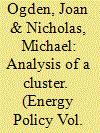

|
|
|
|
|
| Publication |
2011.
|
| Summary/Abstract |
The cost and logistics of building early hydrogen refueling infrastructure are key barriers to the commercialization of fuel cell vehicles. In this paper, we explore a "cluster strategy" for introducing hydrogen vehicles and refueling infrastructure in Southern California over the next decade, to satisfy California's Zero Emission Vehicle regulation. Clustering refers to coordinated introduction of hydrogen vehicles and refueling infrastructure in a few focused geographic areas such as smaller cities (e.g. Santa Monica, Irvine) within a larger region (e.g. Los Angeles Basin). We analyze several transition scenarios for introducing hundreds to tens of thousands of vehicles and 8-42 stations, considering:
|
|
|
|
|
|
|
|
|
|
|
|
|
|
|
|
| 2 |
ID:
177490
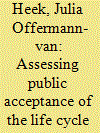

|
|
|
|
|
| Summary/Abstract |
Reducing the high CO2 emissions from the transportation sector requires alternatives to current fossil-based power trains. One possible approach is the development of alternative fuels produced from CO2, water, and renewable energy. Besides technological feasibility of required process steps (CO2 capture, CO2 transport, fuel production infrastructure), a successful adoption requires acceptance of alternative CO2-based fuels and their infrastructure. This study focuses on public acceptance of CO2-based fuels' life cycle by laypeople (N = 325) using conjoint analysis. The laypeople evaluated life cycle scenarios consisting of diverse options regarding CO2 capture, transport, and production infrastructure. To analyze the impact of information on acceptance evaluations, all respondents received information on energy efficiency and environmental impact of the process step options (2nd evaluation stage). The results revealed that CO2 source and transport are most relevant for participants' decisions. Significant impacts of information were found: higher levels of information changed extremely the evaluation of the CO2 capture options (e.g., air capture, chemical plant). The results highlight the importance of investigating laypeople's evaluations of life cycle scenarios, emphasize the relevance of providing adequate information to laypeople, and enable to derive information recommendations to reach a sustained public adoption of alternative fuels and their life cycle.
|
|
|
|
|
|
|
|
|
|
|
|
|
|
|
|
| 3 |
ID:
103612


|
|
|
|
|
| Publication |
2011.
|
| Summary/Abstract |
In a quest for strategic and environmental benefits, the developed countries have been trying for many years to increase the share of alternative fuels in their transportation fuel mixes. They have met very little success though. In this paper, we examine the experience of Argentina with compressed natural gas. We conducted interviews with a wide range of stakeholders and analyzed econometrically data collected in Argentina to investigate the factors, economic, political, and others that determined the high rate of adoption of this fuel. A central objective of this research was to identify lessons that could be useful to developed countries in their efforts to deploy alternative fuel vehicles. We find that fuel price regulation was a significant determinant of the adoption of compressed natural gas, while, contrary to expectations, government financing of refueling infrastructure was minimal.
|
|
|
|
|
|
|
|
|
|
|
|
|
|
|
|
| 4 |
ID:
128003


|
|
|
|
|
| Publication |
2014.
|
| Summary/Abstract |
The Fukushima disaster has lead the French government to release novel cost information relative to its nuclear electricity program allowing us to compute a levelized cost. We identify a modest escalation of capital cost and a larger than expected operational cost. Under the best scenario, the cost of French nuclear power over the last four decades is View the MathML source (at 2010 prices) while in the worst case it is View the MathML source. On the basis of these findings, we estimate the future cost of nuclear power in France to be at least View the MathML source and possibly View the MathML source. A comparison with the US confirms that French nuclear electricity nevertheless remains cheaper. Comparisons with coal, natural gas and wind power are carried out to find the advantage of these.
|
|
|
|
|
|
|
|
|
|
|
|
|
|
|
|
| 5 |
ID:
186431
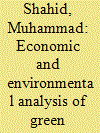

|
|
|
|
|
| Summary/Abstract |
The transport sector is going through a transition from a traditional to a sustainable system. Advanced countries have evaluated the costs and benefits of such transition, however, developing countries like Pakistan have rarely looked into evaluating such transition rigorously. This paper uses the transport sector of Pakistan as a case study and provides an economic evaluation of different scenarios for sustainable transportation in the region. The study has used the Long-range Energy Alternative Planning (LEAP) framework to evaluate the environmental and social costs of three scenarios, Business as Usual Scenario (BAUS), Efficient Combustion Scenario (ECS), and Hybrid Vehicle Scenario (HVS). It concluded that by 2040, the HVS and ECS will reduce carbon dioxide emissions by 303.7 and 213.3 million metric tons respectively compared to BAUS. These savings in terms of social cost will be US$ 10.1 billion in HVS and US$ 7.2 billion in ECS as compared to BAUS. By the year 2040, oil demand in the transportation system will also be possible to contain at the 2026 level. This research is anticipated to help discover the best policy decisions for increasing the share of green fuels in the transport sector of Pakistan.
|
|
|
|
|
|
|
|
|
|
|
|
|
|
|
|
| 6 |
ID:
132617
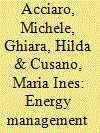

|
|
|
|
|
| Publication |
2014.
|
| Summary/Abstract |
Ports are characterised by the geographical concentration of high-energy demand and supply activities, because of their proximity to power generation facilities and metropolitan regions, and their functions as central hubs in the transport of raw materials. In the last decades the need to better understand and monitor energy-related activities taking place near or within the port has become more apparent as a consequence of the growing relevance of energy trades, public environmental awareness and a bigger industry focus on energy efficiency. The uptake in the port sector of innovative technologies, such as onshore power supply, or alternative fuels, such as LNG, and the increasing development of renewable energy installations in port areas, also calls for more attention to energy matters within port management.
So far, however, few port authorities have actively pursued energy management strategies. The necessity for port authorities to actively manage their energy flows stems from their efforts to plan, coordinate and facilitate the development of economic activities within the port, and as a consequence of the heavier weight that sustainability is given within the port management strategies.
Through the analysis of the experiences of two European ports, Hamburg and Genoa, that have already attempted to coordinate and rationalise their energy needs, this paper will argue that for the ports of the future active energy management can offer substantial efficiency gains, can contribute to the development of new alternative revenue sources and in the end, improve the competitive position of the port.
|
|
|
|
|
|
|
|
|
|
|
|
|
|
|
|
| 7 |
ID:
171363


|
|
|
|
|
| Summary/Abstract |
This paper evaluates the environmental and economic performance of liquefied natural gas (LNG) as a transition fuel to replace diesel in heavy goods vehicles (HGVs). A Well-to-Wheel (WTW) assessment based on real-world HGV drive cycles is performed to determine the life-cycle greenhouse gas (GHG) emissions associated with LNG relative to diesel. The analysis is complemented with a probabilistic approach to determine the total cost of ownership (TCO) across a range of scenarios. The methodologies are validated via a case study of vehicles operating in the UK, using data provided by a large food retailer. The spark-ignited LNG vehicles under study were observed to be 18% less energy efficient than their diesel counterparts, leading to a 7% increase in WTW GHG emissions. However, a reduction of up to 13% is feasible if LNG vehicles reach parity efficiency with diesel. Refuelling at publicly available stations enabled a 7% TCO saving in the nominal case, while development of private infrastructure incurred net costs. The findings of this study highlight that GHG emission reductions from LNG HGVs will only be realised if there are vehicle efficiency improvements, while the financial case for operators is positive only if a publicly accessible refuelling network is available.
|
|
|
|
|
|
|
|
|
|
|
|
|
|
|
|
| 8 |
ID:
115166


|
|
|
|
|
| Publication |
2012.
|
| Summary/Abstract |
This paper evaluates alternative fuels for the Greek road transport sector, using the Analytic Hierarchy Process. Seven different alternatives of fuel mode are considered in this paper: internal combustion engine (ICE) and its combination with petroleum and 1st and 2nd generation biofuels blends, fuel cells, hybrid vehicles, plug-in hybrids and electric vehicles. The evaluation of alternative fuel modes is performed according to cost and policy aspects. In order to evaluate each alternative fuel, one base scenario and ten alternative scenarios with different weight factors selection per criterion are presented. After deciding the alternative fuels' scoring against each criterion and the criteria weights, their synthesis gives the overall score and ranking for all ten alternative scenarios. It is concluded that ICE blended with 1st and 2nd generation biofuels are the most suitable alternative fuels for the Greek road transport sector.
|
|
|
|
|
|
|
|
|
|
|
|
|
|
|
|
| 9 |
ID:
125735


|
|
|
|
|
| Publication |
2013.
|
| Summary/Abstract |
This paper evaluates next generation biomass derived fuels for the transport sector, employing the Analytic Hierarchy Process. Eight different alternatives of fuels are considered in this paper: bio-hydrogen, bio-synthetic natural gas, bio-dimethyl ether, bio-methanol, hydro thermal upgrading diesel, bio-ethanol, algal biofuel and electricity from biomass incineration. The evaluation of alternative fuels is performed according to various criteria that include economic, technical, social and policy aspects. In order to evaluate each alternative fuel, one base scenario and five alternative scenarios with different weight factors selection per criterion are presented. After deciding the alternative fuels' scoring against each criterion and the criteria weights, their synthesis gives the overall score and ranking for all alternative scenarios. It is concluded that synthetic natural gas and electricity from biomass incineration are the most suitable next generation biomass derived fuels for the transport sector.
|
|
|
|
|
|
|
|
|
|
|
|
|
|
|
|
| 10 |
ID:
096140


|
|
|
|
|
| Publication |
2010.
|
| Summary/Abstract |
The search for alternative fuels and new fuel resources is a top priority for Turkey, as is the case in the majority of countries throughout the world. The fuel policies pursued by governmental or civil authorities are of key importance in the success of alternative fuel use, especially for widespread and efficient use. Following the 1973 petroleum crisis, many users in Turkey, especially in transportation sector, searched for alternative fuels and forms of transportation. Gasoline engines were replaced with diesel engines between the mid-1970s and mid-1980s. In addition, natural gas was introduced to the Turkish market for heating in the early 1990s. Liquid petroleum gas was put into use in the mid-1990s, and bio-diesel was introduced into the market for transportation in 2003. However, after long periods of indifference governmental action, guidance and fuel policies were so weak that they did not make sense. Entrepreneurs and users experienced great economical losses and lost confidence in future attempts to search for other possible alternatives. In the present study, we will look at the history of alternative fuel use in the recent past and investigate the alternative engine fuel potential of Turkey, as well as introduce possible future policies based on experience.
|
|
|
|
|
|
|
|
|
|
|
|
|
|
|
|
| 11 |
ID:
125741


|
|
|
|
|
| Publication |
2013.
|
| Summary/Abstract |
The transport sector represents a major item on the global balance of greenhouse gas (GHG) emissions. Natural gas is considered the alternative fuel that, in the short-medium term, can best substitute conventional fuels in order to reduce their environmental impact, because it is readily available at a competitive price, using technologies already in widespread use. It can be used as compressed gas (CNG) or in the liquid phase (LNG), being the former more suitable for light vehicles, while the latter for heavy duty vehicles. The purpose of this paper is to outline the potential of LNG as vehicle fuel, showing positive and negative aspects related to its introduction and comparing the different supply options with reference to the Italian scenario, paying particular attention to the possibility of on site liquefaction. The analysis has highlighted that purchasing LNG at the regasification terminal is convenient up to a terminal distance of 2000 km from the refuelling station. The liquefaction on site, instead, asks for liquefaction efficiency higher than 70% and low natural gas price and, as liquefaction technology, the let-down plants at the pressure reduction points along the pipeline are the best option to compete with direct supply at the terminal.
|
|
|
|
|
|
|
|
|
|
|
|
|
|
|
|
| 12 |
ID:
099300
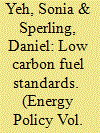

|
|
|
|
|
| Publication |
2010.
|
| Summary/Abstract |
Performance-based low carbon fuel standards (LCFS) of the type implemented in California and being adopted in the European Union, are a promising policy approach for decarbonizing transport fuels and reducing fossil fuel use. This paper examines the efficacy of LCFS policies, along with four major challenges that threaten their effectiveness. These challenges include leakage and shuffling of greenhouse gas (GHG) emissions, impacts on energy security, increased GHG emissions due to global land use conversion (indirect land use changes), and sustainability issues associated with biofuel production. We identify complementary policies that mitigate the severity of these challenges, while noting that some of these challenges are inherent to carbon and alternative fuel policies.
|
|
|
|
|
|
|
|
|
|
|
|
|
|
|
|
| 13 |
ID:
112290


|
|
|
|
|
| Publication |
2012.
|
| Summary/Abstract |
California's target for reducing economy-wide greenhouse gas (GHG) emissions is 80% below 1990 levels by 2050. We develop transition scenarios for meeting this goal in California's transportation sector, with focus on light-duty vehicles (LDVs). We explore four questions: (1) what options are available to reduce transportation sector GHG emissions 80% below 1990 levels by 2050; (2) how rapidly would transitions in LDV markets, fuels, and travel behaviors need to occur over the next 40 years; (3) how do intermediate policy goals relate to different transition pathways; (4) how would rates of technological change and market adoption between 2010 and 2050 impact cumulative GHG emissions?
We develop four LDV transition scenarios to meet the 80in50 target through a combination of travel demand reduction, fuel economy improvements, and low-carbon fuel supply, subject to restrictions on trajectories of technological change, potential market adoption of new vehicles and fuels, and resource availability.
These scenarios exhibit several common themes: electrification of LDVs, rapid improvements in vehicle efficiency, and future fuels with less than half the carbon intensity of current gasoline and diesel. Availability of low-carbon biofuels and the level of travel demand reduction are "swing factors" that influence the degree of LDV electrification required.
|
|
|
|
|
|
|
|
|
|
|
|
|
|
|
|
| 14 |
ID:
150045


|
|
|
|
|
| Summary/Abstract |
A low carbon fuel standard (LCFS) is a market-based policy that specifies declining standards for the average lifecycle fuel carbon intensity (AFCI) of transportation fuels sold in a region. This paper: (i) compares transportation fuel carbon policies in terms of their economic efficiency, fuel price impacts, greenhouse gas emission reductions, and incentives for innovation; (ii) discusses key regulatory design features of LCFS policies; and (iii) provides an update on the implementation status of LCFS policies in California, the European Union, British Columbia, and Oregon. The economics literature finds that an intensity standard implicitly taxes emissions and subsidizes output. The output subsidy results in an intensity standard being inferior to a carbon tax in a first-best world, although the inefficiency can be corrected with a properly designed consumption tax (or mitigated by a properly designed carbon tax or cap-and-trade program). In California, from 2011 to 2015 the share of alternative fuels in the regulated transportation fuels pool increased by 30%, and the reported AFCI of all alternative fuels declined 21%. LCFS credit prices have varied considerably, rising to above $100/credit in the first half of 2016. LCFS programs in other jurisdictions share many features with California's, but have distinct provisions as well.
|
|
|
|
|
|
|
|
|
|
|
|
|
|
|
|
| 15 |
ID:
094401


|
|
|
|
|
| Publication |
2010.
|
| Summary/Abstract |
Concern over increased demand for petroleum, reliable fuel supply, and global climate change has resulted in the US government passing new Corporate Average Fuel Economy standards and a Renewable Fuels Standard. Consequently, the fuel mix for light duty vehicle (LDV) travel in the United States will change over the coming years. This paper explores the embodied water consumption and withdrawal associated with two projections for future fuel use in the US LDV sector. This analysis encompasses conventional and unconventional fossil fuels, corn ethanol, cellulosic ethanol, soy biodiesel, electricity, and hydrogen. The existing mandate in the US to blend ethanol into gasoline had effectively committed 3300 billion liters of irrigation water in 2005 (approximately 2.4% of US 2005 fresh water consumption) for producing fuel for LDVs. With current irrigation practices, fuel processing, and electricity generation, it is estimated that by 2030, approximately 14,000 billion liters of water per year will be consumed and 23,000-27,000 billion liters withdrawn to produce fuels used in LDVs. Irrigation for biofuels dominates projected water usage for LDV travel, but other fuels (coal to liquids, oil shale, and electricity via plug-in hybrid vehicles) will also contribute appreciably to future water consumption and withdrawal, especially on a regional basis.
|
|
|
|
|
|
|
|
|
|
|
|
|
|
|
|
| 16 |
ID:
115656


|
|
|
|
|
| Publication |
2012.
|
| Summary/Abstract |
A well-to-wheels life cycle analysis on total energy consumptions and greenhouse-gas (GHG) emissions for alternative fuels and accompanying vehicle technologies has been carried out for the base year 2010 and projected to 2020 based on data gathered and estimates developed for China. The fuels considered include gasoline, diesel, natural gas, liquid fuels from coal conversion, methanol, bio-ethanol and biodiesel, electricity and hydrogen. Use of liquid fuels including methanol and Fischer-Tropsch derived from coal will significantly increase GHG emissions relative to use of conventional gasoline. Use of starch-based bio-ethanol will incur a substantial carbon disbenefit because of the present highly inefficient agricultural practice and plant processing in China. Electrification of vehicles via hybrid electric, plug-in hybrid electric (PHEV) and battery electric vehicle technologies offers a progressively improved prospect for the reduction of energy consumption and GHG emission. However, the long-term carbon emission reduction is assured only when the needed electricity is generated by zero- or low-carbon sources, which means that carbon capture and storage is a necessity for fossil-based feedstocks. A PHEV that runs on zero- or low-carbon electricity and cellulosic ethanol may be one of the most attractive fuel-vehicle options in a carbon-constrained world.
|
|
|
|
|
|
|
|
|
|
|
|
|
|
|
|
| 17 |
ID:
137752


|
|
|
|
|
| Summary/Abstract |
Despite private investments exceeding two billion Euros and tax incentives of more than 500 million Euros, the market share of natural gas vehicles (NGVs) in Germany has lagged far behind expectations and behind market developments in other countries. With total cost of ownership being on average lower for NGVs than for gasoline and diesel vehicles this raises the question of the existence of market failure in the German NGV-market. We use a case study approach where we combine quantitative data with insights from a multi-industry expert panel and in-depth interviews with experts from industry, government and civil society in order to examine whether and how different types of market failure contribute to the status quo in the German market for NGVs. We conclude that coordination failure in complementary markets, an artificially created monopoly of service stations at motorways, imperfect information, bounded consumer rationality, and principle-agent-problems are the most prominent market failures inhibiting the development of a functioning market for NGVs. Our results are instructive for the design of effective public policies and investor strategies aiming to create markets for alternative fuel vehicles.
|
|
|
|
|
|
|
|
|
|
|
|
|
|
|
|
| 18 |
ID:
088995


|
|
|
|
|
| Publication |
2009.
|
| Summary/Abstract |
In this paper, the potential for the transportation sector to develop in a way that is consistent with long-term climate targets will be discussed. An important question is whether technical measures will be sufficient for reaching long-term climate targets. Although there is a large potential to significantly increase the use of bioenergy from today's level, there will be severe restrictions to its use within the transportation sector. Other renewable energy sources such as wind and solar are much more abundant and could provide the majority of the necessary transportation fuel in the long run. Although potentially much more expensive than current fuels they could, in combination with strong efficiency improvements, provide transport services at costs that could be acceptable in a growing economy. Transport levels as high as today or even higher could be consistent from a climate perspective if such fuels and technologies are utilised. Relying only on technical measures would, however, be risky, as there is no guarantee that the technology will develop at a sufficient rate. Furthermore, the existence of other negative environmental effects would argue for the implementation of measures affecting transport demand as well.
|
|
|
|
|
|
|
|
|
|
|
|
|
|
|
|
|
|
|
|
|